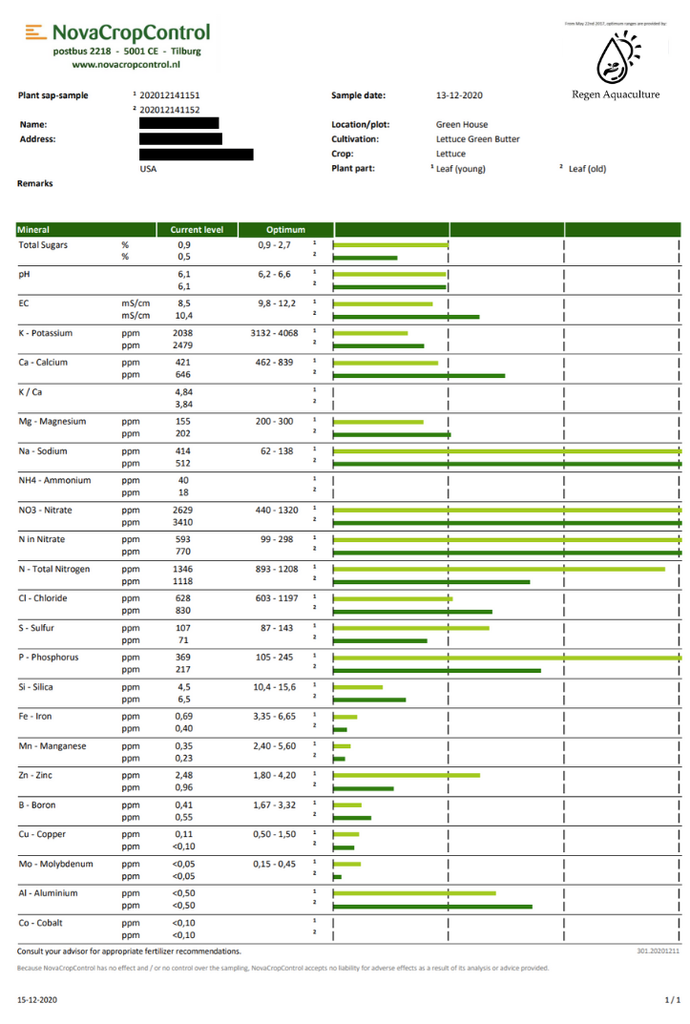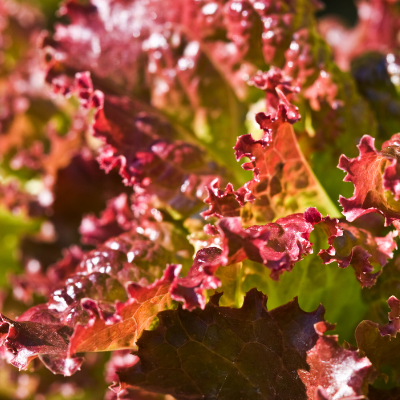Plant Sap Analysis Testing (Old + Young Leaves)
Our comprehensive sap analysis provides detailed insights into the nutrient status of your plants, covering a wide range of parameters including pH, Brix, EC, Chloride, Sulfur, Phosphorus, Calcium, Potassium, K/Ca Ratio, Magnesium, Sodium, Aluminum, Boron, Cobalt, Copper, Iron, Manganese, Molybdenum, Nickel, Selenium, Silica, Zinc, Nitrogen from Ammonium, Nitrogen from Nitrate, Total Nitrogen, and Nitrogen Conversion Efficiency. Each package includes two tests, one for old and one for young leaves. Comparison of these allows us to determine nutrient flow within the plant and adjust fertilizer recipes.
Plant Sap Analysis Frequently Asked Questions
- pH: pH levels affect nutrient availability in the soil. Plants thrive in slightly acidic to neutral conditions.
- Brix: Indicates the sugar content in plant sap, which can reflect plant health and resilience to stress.
- EC (Electrical Conductivity): a general indicator of the conductivity of the plant cell which is indicative of cation anion imbalances.
- Chloride: Essential for plant growth, but high levels can be toxic and inhibit nutrient uptake.
- Sulfur: Vital for the formation of proteins and enzymes, contributing to plant growth and vigor.
- Phosphorus: Crucial for energy transfer and storage in plants, vital for root development, flowering, and fruiting.
- Calcium: Important for cell wall structure and strength, aids in nutrient uptake and enzyme activity.
- Potassium: Essential for water regulation, enzyme activation, and overall plant health and vigor.
- K/Ca Ratio: Balance between potassium and calcium is important for plant growth, as both are essential nutrients.
- Magnesium: Central to chlorophyll synthesis, crucial for photosynthesis and overall plant growth.
- Sodium: Required in small amounts, but excess can be detrimental to plant health, affecting nutrient uptake and water balance.
- Aluminum: Toxic at high levels, can inhibit root growth and nutrient uptake.
- Boron: Essential for cell wall formation, pollination, and seed development.
- Cobalt: Essential for nitrogen fixation in legumes, aiding in overall plant nitrogen uptake.
- Copper: Important for enzyme activation and photosynthesis, but toxic at high levels.
- Iron: Essential for chlorophyll formation and enzyme functions, vital for photosynthesis.
- Manganese: Involved in enzyme activation, photosynthesis, and nitrogen metabolism.
- Molybdenum: Essential for nitrogen fixation and enzyme activation.
- Nickel: Plays a role in nitrogen metabolism and enzyme activity.
- Selenium: Important for antioxidant defense systems in plants.
- Silica: Enhances plant rigidity and strength, reducing susceptibility to pests and diseases.
- Zinc: Essential for enzyme activation, growth regulation, and nutrient uptake.
- Nitrogen from Ammonium: One of the primary forms of nitrogen uptake by plants, essential for protein synthesis and growth.
- Nitrogen from Nitrate: Another important form of nitrogen uptake by plants, especially in aerobic conditions.
- Total Nitrogen: The sum of nitrogen in all forms, crucial for overall plant growth and development.
- Nitrogen Conversion Efficiency: Reflects the plant's ability to convert available nitrogen into proteins and other essential compounds, indicating nutrient use efficiency.
- Farmers that wish to improve crop productivity and health
- Agronomists, Crop Advisors and Consultants who make fertilizer recommendations
- Organic growers looking to maximize the organic method
- Conventional growers looking to minimize fertilizer costs
- Students of Agriculture/Horticulture
In Tissue Analysis, the plant fluids within the plant leaf are excluded and the cellular tissue is analyzed.
In Leaf Extract Analysis, the cellular fluids are analyzed and the tissue components are excluded.
- How to optimize fertilization
- General plant health by primary indicators
- Balance of nutrients in different parts of the plant
- Toxic elements that are causing plant stress
- Nitrogen excess/deficiency
- Micronutrient deficiencies
- Nutrient management preferences by cultivar
- And much more…
The mineral content of the plant fluids is a predictive indicator of plant tissue content.
By analyzing the plant fluids during transport prior to becoming part of the plant tissue, the mineral needs and excesses of the plant can be adjusted.
Sap testing implies a number of different protocols. In some forms, plant leaves are juiced to a pulp and analyzed in the field for 1-5 nutrient analytes using portable meters.
In Leaf Extract Analysis, the pure cellular fluids of the plant are extracted and analyzed on precision laboratory equipment for 22 or more analytes.
We employ a multi-stage process that excludes the vascular transport bundles, cellular wall structures and other tissue components. The process produces pure plant fluids to be used for analytical purposes.
We utilize scientifically accepted scientific methods for plant-matrix analysis using precision laboratory techniques for sub-part-per-million quantitation.
To obtain optimal results, we work directly with growers to pave the path to soil health, crop productivity and farm profitability.
Contact us for more information.
- Precision forecasting of plant needs based on analysis results
- Custom Data interpretation
- Detailed Crop Fertilizer Recommendations
- Custom Foliar Nutrition Blends
- Custom Biological Inoculant Recommendations
- Biological-Nutrient Synergy
Follow the steps below for successful sample submission.
01. Select Crop-Specific Sampling Guides
We start by understanding your project goals and design requirements.
02. Complete Labels & Submit Samples
Our team creates detailed plans for aquaponic and hydroponic systems that seamlessly integrate into your building and processes.
03. Analyze Your Results
We handle the installation and setup of the system.
04. Follow Advice
We offer ongoing training and support to ensure the long-term success of your system, helping you maintain a beautiful and sustainable garden. to remove some steps.
Alternative Products
These other products might interest you
%20(Add%20detailed%20recommendations.)?unique=73ec318)


%20(Add%20detailed%20recommendations.)?unique=73ec318)

